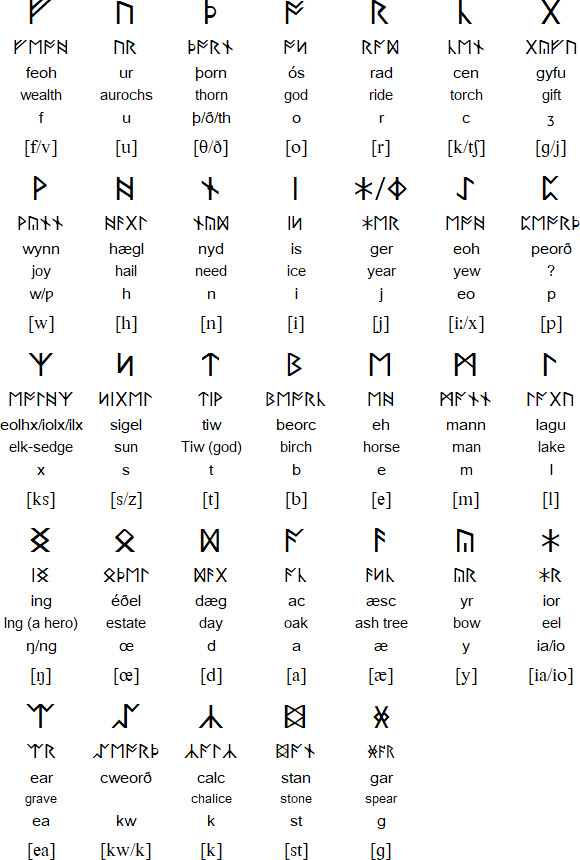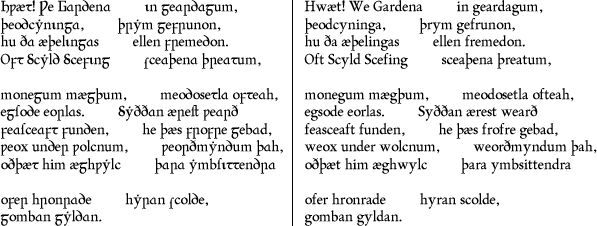Old English / Anglo-Saxon was first written with a version of the Runic alphabet known as Anglo-Saxon or Anglo-Frisian runes, or futhorc/fuþorc. This alphabet was an extended version of Elder Futhark with between 26 and 33 letters. Anglo-Saxon runes were used probably from the 5th century AD until about the 10th century. They started to be replaced by the Latin alphabet from the 7th century, and after the 9th century the runes were used mainly in manuscripts and were mainly of interest to antiquarians. Their use ceased not long after the Norman conquest.
Runic inscriptions are mostly found on jewellery, weapons, stones and other objects, and only about 200 such inscriptions have survived. Most have been found in eastern and southern England.

Download an chart of Anglo-Saxon runes (Excel speadsheet)
Old English alphabet

Notes
- Long vowels were marked with macrons. These were not written originally used in Old English but are a more modern invention to distinguish between long and short vowels.
- The alternate forms of g and w (yogh and wynn/wen respectively) were based on the letters used at the time of writing Old English. Today they can be substituted for g and w in modern writing of Old English.
- Yogh originated from an insular form of g and wynn/wen came from a runic letter and was used to represent the non-Latin sound of [ w ]. The letters g and w were introduced later by French scribes. Yogh came to represent [ ç ] or [ x ].
Other versions of the Latin alphabet
Archaic Latin alphabet, Basque-style lettering, Carolingian Minuscule, Classical Latin alphabet, Fraktur, Gaelic script, Merovingian, Modern Latin alphabet, Roman Cursive, Rustic Captials, Old English, Sütterlin, Visigothic Script
Old English pronunciation

Notes
- c = [ʧ] usually before or after a front vowel, [k] elsewhere
- ð/þ = [θ] initially, finally, or next to voiceless consonants, [ð] elsewhere
- f = [f] initially, finally, or next to voiceless consonants, [v] elsewhere
- g (ʒ) = [ɣ] between vowels and voiced consonants, [j] usually before or after a front vowel, [ʤ] after n, [g] elsewhere
- h = [ç] after front vowels, [x] after back vowels, [h] elsewhere
- n = [ŋ] before g (ʒ) and k
- s = [s] initially, finally, or next to voiceless consonants, [z] elsewhere
- The letters j and v were rarely used and were nothing more than varients of i and u respectively.
- The letter k was used only ever rarely and represented [k] (never [ʧ])
Download an alphabet chart for Old English (Excel speadsheet)
Sample text in Old English (Prologue from Beowulf)

Modern English version
LO, praise of the prowess of people-kings
of spear-armed Danes, in days long sped,
we have heard, and what honor the athelings won!
Oft Scyld the Scefing from squadroned foes,
from many a tribe, the mead-bench tore,
awing the earls. Since erst he lay
friendless, a foundling, fate repaid him:
for he waxed under welkin, in wealth he throve,
till before him the folk, both far and near,
who house by the whale-path, heard his mandate,
gave him gifts:
of spear-armed Danes, in days long sped,
we have heard, and what honor the athelings won!
Oft Scyld the Scefing from squadroned foes,
from many a tribe, the mead-bench tore,
awing the earls. Since erst he lay
friendless, a foundling, fate repaid him:
for he waxed under welkin, in wealth he throve,
till before him the folk, both far and near,
who house by the whale-path, heard his mandate,
gave him gifts:
A recording of this text:
Sample text in Old English (Article 1 of the UDHR)
Ealle fīras sind boren frēo ond geefenlican in ār ond riht. Hīe sind gifeðe gerād ond ingehygd, ond sculon dōn ongēan oðrum be feore of brōþorhāde.
Translation by Matthew Leigh Embleton
Modern English version
All human beings are born free and equal in dignity and rights. They are endowed with reason and conscience and should act towards one another in a spirit of brotherhood.
(Article 1 of the Universal Declaration of Human Rights)
(Article 1 of the Universal Declaration of Human Rights)
No comments:
Post a Comment